Za’atar is and has been a staple in Middle Eastern cuisine since the 13th century. If you don’t have a lot of experience with Middle Eastern cuisine, za’atar is a great way to start because it’s tasty and versatile. This spice mix contains all of the delicious flavors you could ever ask for in a pinch. Just a little sprinkle of za’atar will make any dish better!
What Is Za’atar?
The name “za’atar” can refer to both the herb itself and the spice mix. The za’atar herb (Origanum syriacum) has a savory flavor, similar to thyme and oregano. The fresh za’atar leaves are commonly used in baking bread and in salads. The za’atar herb can be quite difficult to find outside of the Levant region due to its cost and scarcity, but many Middle Eastern stores in the U.S. carry pre-packaged za’atar spice mixes.
The za’atar spice blend gets its name from the za’atar herb which originally made up the bulk of the mix. However, the herb is becoming more hard to find and more expensive, so thyme and oregano are used as alternatives instead. Thyme and oregano are related to the za’atar herb so their flavors are very similar.
Every region and family has their own version of za’atar so the spices used in the mix can vary. The most common spices include thyme, oregano, sumac, sesame seeds, and marjoram. Although za’atar is a combination of spices, it’s considered to be a condiment instead of a spice. It’s not used much in cooking, but as an added flavoring to prepared dishes. For example, you wouldn’t use it to season a pot of soup, but you could sprinkle it over hummus or tahini.
Types of Za’atar
There are two main types of Za’atar: red and green za’atar. Red za’atar contains a significant amount of sumac, which is a bright red berry that gives red za’atar its coloring. The flavor of sumac is citrusy and tangy, like lemon juice. Green za’atar contains more dried za’atar leaves or thyme and will have a nutty, herby flavor. Green za’atar may still contain sumac, but a lot less than red za’atar. In general, za’atar mixes that are more red in color will contain more sumac and less za’atar leaves and za’atar mixes that are more green will have more za’atar leaves and less sumac. There are many other types of za’atar depending on which country or region you go to, but red and green za’atar are the most common.
Uses
These uses of za’atar are endless, whether it’s being used for tradition Middle Eastern dishes or being adapted for other cuisines. The most common way of eating za’atar in the Middle East is on pita bread that has been dipped in olive oil, but this spice blend is extremely versatile and goes well with just about anything. Here are a few foods a sprinkle of za’atar would go well with:
- Salads
- Sandwiches
- Hummus
- Dips
- Baked Bread
- Toast
- Roasted meats or seafood
- Roasted vegetables
- Cheese
- Eggs or shakshuka
- Roasted potatoes
Recipes for making za’atar at home are available online or you can readily find premade mixes at Middle Eastern grocery stores. Or, you can browse our selection of za’atar mixes on the MEA Imports website.
-
Product on sale
 JANNAH Zaatar 40lbOriginal price was: $99.60.$88.00Current price is: $88.00.
JANNAH Zaatar 40lbOriginal price was: $99.60.$88.00Current price is: $88.00. -
 JANNAH Red Za’atar 14.1oz/400g x 20$55.00 – $59.99
JANNAH Red Za’atar 14.1oz/400g x 20$55.00 – $59.99


